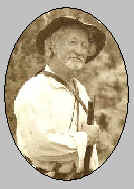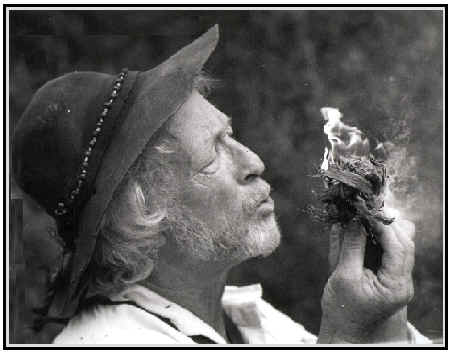|
Smoke Signals May/Jun 2012
|
||
|
BILL
CUNNINGHAM |
Blowin' Smoke
|
|
|
WHEELS IN
THE WILDERNESS The
names of the original mountain men are often recalled during
conversations around rendezvous camp fires. Many times the names of
what today are the most famous are discussed: Meek, Bridger, Carson,
Williams, Wolfskill, Young, Yount, Fitzpatrick, Glass, Smith, and so
on. These were men of daring and courage, supposedly unexcelled in the
knowledge of survival and trapping. But there were other mountain men
as well practiced, as well admired by their peers, and perhaps even
more experienced. These were men widely known during the fur trade
days as ones to ride with, men who were often credited with teaching
some of the now better known men. And who knows why one man should be
longer remembered than another. Be that as it may, it really pays off
to research the journals, diaries, and letters from the era. Of course
there are shortcuts that can be taken by reading what has already been
written by biographers and historians. “He was
of medium height, stout frame , and fine face. He was full of humanity,
memory, an good will, genial feeling, and frankness. He possessed a
remarkable memory, and, though slow of speech, his narrations were
most interesting.” Another
friend, Jesse Applegate, described him this way:”Though Newell
came to the mountains from the State of Ohio in his youth, he brought
with him to his wild life some of the fruits of early culture which he
always retained. Though brave among the bravest he never made a
reckless display of that quality, and in battlefields as in councils,
his conduct was always marked by prudence and good sense. Though fond
of mirth and jollity and the life of social reunions, he never
degenerated from the behavior and instincts of a gentleman. Though his
love of country amounted to a passion and his mountain life was spent
in opposition and rivalry to the Hudson’s Bay Company, he never
permitted his prejudices to blind his judgement, or by word or act to
do injustice to an adversary.” Newell was
well traveled in the mountains and attended several rendezvous. Among
the companions he noted in his journal are Meek, Jed Smith, Robert
Campbell, Bridger, Jackson, the Sublettes, Moses Harris (who at one
time tried to murder Newell), Carson, Fraeb, Fitzpatrick, and others.
He was at Fort Hall often enough to be well known there and trusted.
He was referenced in the journals of several men as being at the sites
of numerous tangles with the Blackfeet. In one Meek tells of a tussle
Doc had with a wounded warrior he thought dead. Entwining his hand in
the Indian’s thick hair in order to scalp him, he was surprised by
the fellow suddenly coming around and grappling him. The two fought
furiously for a time, Doc’s fingers so entangled in the hair that he
could not let go. But eventually he won out, of course. A Mr. Elwood Evans later gave a
more detailed account of the trip as told to him by Doc. “Let me now
refer to the statement of the late Dr. Robert Newell, Speaker of the
House of Representatives of Oregon in 1848, a name familiar and held in
high remembrance by ancient Oregonians. It is interesting for its
history, and in the present occasion illustrates the difficulty, at that
time, of getting to Oregon. It details the bringing of the first wagon
to Fort Walla Walla, Oregon, in 1840, the Wallula of Washington
Territory. The party consisted of Dr. Newell and family, Col. Jos. L.
Meek and family, Caleb Wilkins of Tualatin Plains, and Frederick
Ermatinger, a chief factor of the Hudon’s Bay Company. It had been
regarded as the height of folly to attempt to bring wagons west of Fort
Hall. The Doctor suggested the experience. Wilkins approved it and
Ermatinger yielded. The Revs. Harvey Clark, A.B. Smith and P.B.
Littlejohn, missionaries, had accompanied the American Fur Company’s
expedition as far as Green River, where they employed Dr. Newell to
pilot them to Fort Hall. On arriving there they found their animals so
reduced, that they concluded to abandon their two wagons and Dr. Newell
accepted them for his services as guide. In a letter from the Doctor, he
says: “At the time I took the wagons, I had no idea of undertaking
these missionaries for their animals, and after they had gone a month or
more for Willamette and the American Fur Company had abandoned the
country for good, I concluded to hitch up and try the much dreaded job
of bringing a wagon to Oregon. I sold one of those wagons to Mr.
Ermatinger at Fort Hall. Mr. Caleb Wilkins had a small wagon which Joel
Walker had left at Fort Hall. On the 5th of August (September
27) 1840, we put out with three wagons. Joseph L. Meek drove my wagon.
In a few days we began to realize the difficulty of the task before us,
and found that the continual crashing of the sage under our wagons,
which was in many places higher than the mules’s backs, was no joke.
Seeing our animals begin to fail, we began to light up, finally threw
away our wagon beds, and were quite sorry we had undertaken the job, All
the consolation we had was that we broke the first sage on that road,
and were too proud to eat anything but dried salmon skins after our
provisions had become exhausted. In a rather rough and reduced state, we
arrived at Dr. Whitman’s mission station in the Walla Walla valley,
where we met that hospitable man, and kindly made welcome and feasted
accordingly. On hearing me regret that I had undertaken to bring wagons,
the Doctor said,’O, you will never regret it. You have broken the ice,
and when others see that wagons have passed they too will pass, and in a
few years the valley will be full of our people.’ The Doctor shook me
heartily by the hand; Mrs. Whitman too welcomed us, and the Indians
walked around the wagons, or what they called “horse canoes,” and
seemed to give it up. We spent a day or so with the Doctor and then went
to Fort Walla Walla, where we were kindly received by Mr. P.C. Pambrum,
chief trader of Hudson’s Bay Company, superintendent of that post. On
the first of October we took leave of those kind people, leaving our
wagons and taking the river trail - but we proceeded slowly.” Ref:
Leroy R. Hafen: Mountain Men and the Fur Trade vol. VIII Bill Cunningham NAF #006 |
||



